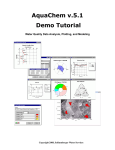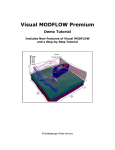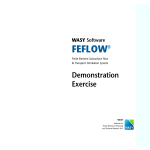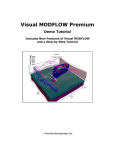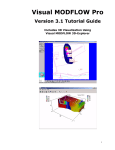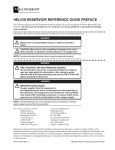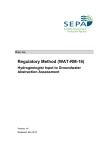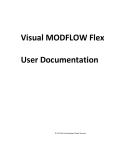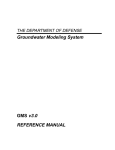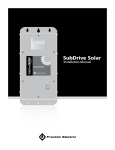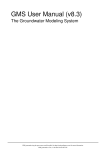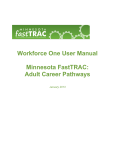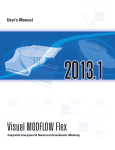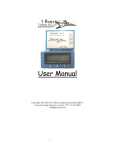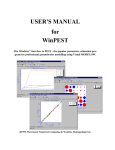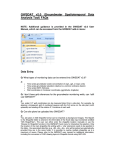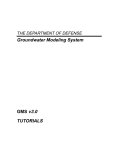Download 2005 Waterloo Hydrogeologic E-News!
Transcript
September Edition » GW Contour: A Powerful Data Contouring & Visualization Program Designed Specifically for Groundwater Professionals! NEW PRODUCT ANNOUNCEMENT: GW Contour for Windows 2000/XP Pro GW Contour: A Powerful Data Contouring & Visualization Program Designed Specifically for Groundwater Professionals! » WHI Completes Available now at our limited-time introductory price! Caribbean Saltwater Intrusion Investigation » WHI's Line-Up of Environmental & Groundwater Modeling Courses! Upcoming Professional Courses: » Applied Groundwater Flow & Contaminant Transport Modeling GW Contour: A Powerful Data Contouring & Visualization Program Designed Specifically for Groundwater Professionals! GW Contour, developed by Waterloo Hydrogeologic, Inc., represents the first data interpolation and contouring program to also incorporate advanced techniques for mapping velocity vectors and particle pathlines – all within one, easy-to-use program! GW Contour offers the perfect combination of tools and techniques for groundwater and environmental professionals. Click here for a free demo. Professional Applications of GW Contour » GIS Data Management for Groundwater Modelers » Groundwater Flow and Contaminant Transport Modeling for Risk » NGWA - GIS Data Management for Groundwater Modelers ● ● ● ● ● ● ● » NGWA The Graphical mapping and reporting of groundwater levels Preliminary interpolation and contouring of contaminant concentrations (groundwater, soil, or air) Assessing groundwater flow direction and magnitude Contouring data obtained from pumping tests, dataloggers, groundwater monitoring events, weather stations, groundwater models, borehole logs, etc. Gridding ground surface elevations for use in groundwater flow models, or GIS Analyzing exposure pathways when assessing human health risk Comparing conceptual interpretations with calculated interpretations Contaminant concentrations with velocities MODFLOW Course Whether contouring elevations, contaminant concentrations, or other spatially variable data, GW Contour has the techniques and tools necessary to map and report your data in a professional manner. Contouring topography » WEL1 versus FWL4 package when running MODFLOW-SURFACT from within Visual MODFLOW Features & Benefits ● ● ● » Van Essen Instruments - ● Divers in China ● ● Printer Friendly Version ● Provides an all-in-one solution for interpolating and mapping groundwater and environmental data Offers the unique ability to calculate forward and reverse particle movements Capable of calculating velocity vectors (magnitude and direction), important for groundwater projects Quick and easy georeferencing of raster-based images used as basemaps Advanced interpolation techniques to address various data sets Intuitive and logical graphical user interface design Handles a wide range of environmental units Water table contours BUY NOW AND SAVE WITH OUR SPECIAL LIMITED-TIME INTRODUCTORY PRICE. GW Contour is now available for purchase for only US$395! Multi-User, Government, and Educational Discounts available Mapping water quality Waterloo Hydrogeologic has been providing software solutions for groundwater and environmental professionals since 1989. Since the beginning, our users have demanded - and received - easy-to-use, intuitive software applications to address their project needs. We are proud to be releasing GW Contour as an integral part of our industryrecognized suite of groundwater and environmental software products. Note on Beta Testing Program for GW Contour 1.0 We are proud to announce that the GW Contour Beta Testing program was a big success, with over 90 participants. We very much appreciate the time that the beta testers took to evaluate the software and send us their findings. We are confident that with the implementation of many of your suggestions, GW Contour will prove to be a valuable tool for a wide range of users! Those suggestions that have not been included in this release will be considered for future software updates. As a token of WHI's appreciation for the major contributions of Mr. Tony Burgess and Mr. Yves LeBlanc, and for their commitment and enthusiasm, we are pleased to announce that they will receive a free copy of GW Contour 1.0! Learn more about GW Contour! For more information, about GW Contour, please visit our website or contact us today: Website: http://www.waterloohydrogeologic.com Email: [email protected] Phone: (519) 746-1798 Assessing flow pathlines WHI Completes Caribbean Saltwater Intrusion Investigation Objective and Background The objective of this investigation was to assess the impact of a planned coastal construction project on a shallow groundwater system, and to assist in developing strategies to reduce potential negative effects To represent freshwater and saltwater conditions properly, density dependent flow induced by density differences had to be taken into account. Prior to developing the numerical model, available hydrogeologic data representing the site was compiled and interpreted to create a conceptual geological model of the study area. The design of Figure 1. FEFLOW model and pre- marina the proposed marina was incorporated into the 3D model as a construction distribution of TDS (salinity) geometrical boundary. Density Dependant Model Because of its advanced capabilities to simulate complex groundwater flow systems involving density dependent conditions, the FEFLOW package was applied to solve this modeling task. An unconfined (phreatic) aquifer with saturated layers was considered to be an appropriate conceptualization to represent the groundwater system. Additionally, steady density dependent flow and mass transport were taken into account as coupled processes. The definition of a well posed density dependent 3D problem is primarily controlled by the flow and mass transport boundary conditions and constraints. Figure 1 shows the FEFLOW model that was developed and the pre-marina construction distribution of TDS (salinity). Figure 2. Plan view distribution of TDS after marina construction (marina shown with black outline). Modeling Results The proposed marina channel was predicted to produce an upconing effect, and had the function of a drainage element increasing outflow velocities, as shown in Figure 2. For this particular hydrodynamic situation, the modeling results suggested that the strongest impact was expected in the vertical rather than in the lateral direction. This is shown in Figure 3, which presents a 3D view of the predicted upconing at the proposed marina. Based on the completion of additional simulations, the expected lateral depletion of the fresh water lens appears to be small. This is supported by the extremely steep gradient developed towards the discharge boundary. The numerical problem converged within a few iterations, and accurate water balance and tolerable mass imbalances confirmed that the model converged on the appropriate solution. Figure 3. Predicted saltwater upconing below the proposed marina Learn more about WHI's Consulting Services! For more information related to this topic, or if you would like more information about WHI's Consulting Services and capabilities, please visit our website or contact us today: Website: http://www.waterloohydrogeologic.com/consulting/consulting_services.htm Email: [email protected] Phone: (519) 746-1798 WHI's Line-Up of Environmental & Groundwater Modeling Courses! The 2005 Waterloo Hydrogeologic Open Enrollment schedule has been set. In response to comments from groundwater professionals who have taken our Groundwater Modeling Courses in the past, and from those who would like to attend courses in the future, WHI has combined the strengths of our previous Groundwater Modeling, Advanced Groundwater Modeling, and Model Calibration courses into one Applied Groundwater Flow & Contaminant Transport Modeling course. This course includes updated lecture material, as well as new hands-on laboratories to support the new course material. WHI has also created a new short course entitled GIS Data Management for Groundwater Modelers, which teaches the theory and hands-on application of GIS data integration and interpolation to support groundwater modeling efforts, as well as 3-dimensional visualization of modeling results in Visual MODFLOW, HydroGeo Analyst, and GIS environments. Click on the titles below and see which courses are appropriate for you! » Applied Groundwater Flow & Contaminant Transport Modeling - NEW » Groundwater Contamination & Remediation - UPDATED » Finite Element Groundwater Modeling - UPDATED » Aquifer Test Analysis - NEW » Unsaturated Zone Modeling and Evaluation of Landfill Impacts - UPDATED » The Human Health Risk Assessment Course - NEW » Water Quality Data Management & Modeling - UPDATED » Regulatory Review of Hydrogeology Studies - UPDATED » GIS Data Management for Groundwater Modelers - NEW Who Can Benefit? » Experienced hydrogeologists with no prior groundwater modeling experience » Regulators who review modeling reports » Managers who want to understand what the modelers are doing » Experienced modelers who want to enhance their skills » Students who want to acquire new skills » Lawyers who want to understand some of the technical issues » Industry professionals who want to understand more about what their consultants are telling them For further details on any of these courses, please visit our website, or contact Miln Harvey, WHI Training Manager, at (519) 746-1798 x233. Can't make it to one of our Open Enrollment Courses? Call us about our On-Site Custom courses designed to suit your specific needs! Theory and Hands-on Applications using MODFLOW-2000, MODPATH, MT3D & WinPEST Simple to complex applications of groundwater flow and contaminant transport models are covered in this 4-day hands-on course. Course Objectives and Benefits ● ● ● Apply Visual MODFLOW Pro to 3D groundwater flow and contaminant transport projects Use MODFLOW-2000 to develop several groundwater flow models Calibrate your groundwater models to observed field data Bejing, China Oct 31-Nov 4, 2005 Sao Paulo, Brazil Nov 8-11, 2005 Melbourne, ● ● ● ● Use MODPATH particle tracking features to determine preferential flow paths and delineate capture zones Use ZoneBudget to assess subregional water budgets within your groundwater model Simulate 3D contaminant transport using RT3D, MT3DMS & MT3D99 Use WinPEST to improve model calibration and understand model uncertainty Australia Nov 15-17, 2005 For more details please click here. This 3-day course goes beyond an introduction to the development, calibration and optimization of groundwater flow and transport models to provides hands-on experience in more advanced topics. Melbourne, Australia Nov 21-22, 2005 For more details please click here. Understanding Data Sources, Data Analysis and Visualization Waterloo,Ontario, December 6-8, 2005 This 3-day hands-on course presents an introduction to the management and analysis of groundwater data for Visual MODFLOW modelers. For more details please click here. Princeton, NJ, Oct 25 -28, 2005 The MODFLOW Course Theory & Hands-on Applications using MODFLOW2000, MODPATH, MT3D & WinPEST Groundwater modeling is becoming a much more complicated, yet highly integrated component of hydrogeologic analysis and design. This 4-day course introduces the ground water modeling process, and discusses the development of simple to complex groundwater models using MODFLOW-2000, MODPATH, ZoneBudget, MT3D/RT3D. New exercises have been added to show the use of MGO for pumping well optimization and SEAWAT for saltwater intrusion into coastal aquifers. The course ends with the analysis of model calibration using WinPEST to assess the quality of model calibration, and the impact of parameter input uncertainty on model prediction uncertainty. For more details please click here. To register for this course you must be a member of the NGWA, if you are not please call NGWA Customer Service at 800-551-7379, or email Columbus, Ohio Oct. 19-20, 2005 This 2-day hands-on course presents an introduction to the management and analysis of groundwater data for Visual MODFLOW modelers. Data management begins with the development of a site GIS using a common georeference system, which integrates the many different sources of groundwater data that are needed to develop a groundwater model. This data is then interpreted and interpolated within the GIS to generate model cross-sections, parameter distributions, model layer interfaces and model boundary conditions as part of developing the hydrogeologic conceptualization. For more details please click here. To register for this course you must be a member of the NGWA, if you are not please call NGWA Customer Service at 800-551-7379, or email For our full 2005 training schedule, click here! To request your free 2005 Training Course Schedule Catalog, click here! For more information about our course offerings, visit our website or contact us today: Website: www.waterloohydrogeologic.com/training/training.htm Email: [email protected] Phone: (519) 746-1798 WEL1 versus FWL4 package when running MODFLOW-SURFACT from within Visual MODFLOW Visual MODFLOW 4.1 has an interface designed to work with the MODFLOW-SURFACT variablysaturated flow modeling engine, developed by HydroGeoLogic, Inc.. As part of the MODFLOW-SURFACT package, HGL added a new well package to the U.S. Geological Survey Modular Groundwater Flow Model (MODFLOW) that simulates a wellbore as a high conductivity fracture tube. This package, which is an alternative to the existing (WEL1) package in MODFLOW, is referred to as the Fracture-Well (FWL4) Package. The FWL4 Package is designed to overcome several problems associated with the original WEL1 Package. First, the FWL4 Package truly emulates a multilayer well. This is because the fracture tube representation allows connection of aquifer cells (nodes) that are associated with the well to 1-D finite diameter cylindrical well-cells. Additionally, the total withdrawal rate prescribed for the well is rigorously incorporated. Volumetric fluxes from each individual node associated with the fracture well are automatically computed by the code to sum to the total withdrawal from the well. On the other hand, the original WEL1 Package implements only a priori known source/sink term at an aquifer node representing a well. Therefore, it requires the user to determine the contribution of each node to the physical well that penetrates two or more nodes. These nodal flux contributions are typically estimated such that the prescribed withdrawal rate is apportioned according to the transmissivities of the contributing well nodes. Such an estimation may result in a calculation error by MODFLOW. Furthermore, for unconfined systems, prescribing the nodal fluxes according to the WEL1 Package could cause computational difficulties in addition to misrepresenting the physical system. The FWL4 Package, however, automatically apportions the net well withdrawal (input by the user) to the well nodes. For each time step, the computed nodal fluxes may vary substantially, as is the case in the event of desaturation and resaturation of individual layers. Another feature of the new FWL4 Package is that for an overpumped unconfined system, the total well withdrawal is automatically adjusted when the water level in the well has reached the well bottom. At this stage, the hydraulic head at the bottom well node is fixed at well-bottom conditions, and the total withdrawal is computed to correspond to the feasible quantity that the well can supply under these conditions. If a situation occurs whereby the withdrawal demand is less than what the well can supply at bottom-hole pressure conditions (i.e., if the pump is shut off for a particular period, or recharge is increased), the hydraulic heads at the well nodes will bounce back to reflect these new conditions, and the well will provide the full withdrawal demand. The previous WEL1 Package does not physically adjust the pumping rate when the water level drops below the bottom of the well. Instead, it continues the computation into the non-physical realm, with the head values at the well nodes continually dropping below the well-bottom elevation. On other occasions, the WEL1 Package causes the system to become computationally unstable by cyclically drying and wetting the pumping cells between iterations. The FWL4 Package also implements well-bore storage, which is neglected in previous versions of MODFLOW. It should be noted that as in previous MODFLOW versions, the fracture-well package does not incorporate a local logarithmic function within a grid block corresponding to the well node. Thus, a refined areal discretization is still required in the vicinity of each well if the user is interested in accurate predictions of local drawdowns. Finally, the FWL4 Package is intended for use only with the rigorous variably saturated simulation option (i.e., input LAYCON = 40 or 43) of the BCF4 Package. Withdrawal continues at the prescribed rate in each well until the water level in the well reaches the well bottom. This bottom elevation of a well is physically located anywhere in the lowest nodal layer that is screened. When the piezometric head at the lowest well node corresponds to the bottom elevation of a well, the head values are held fixed and the well yield is allowed to fall below the demand. If at a later stage, the aquifer system recovers and the well yield increases to be larger than the demand, or if the demand drops below the yield, the well reverts to withdrawing water at the prescribed pumping rate. The total well yield and contributions of each layer to the well yield are reported in the output file. To select the FWL4 well package within Visual Modflow, select Run (from the Run Menu) to activate the Engines to Run dialog box. Then select the Advanced button to reveal the settings field. Change the settings to User Defined, then select the “…” box and select the Well Package you prefer. It is important to note the following limitations when working with the FWL4 package: ● ● ● The LAYCON value for each layer must be 40 or 43 Multi-screen wells are not supported All wells must be active in your project (wells cannot be inactive during a simulation, they must be deleted For further information regarding the FWL4 well package, please refer to the MODFLOW-SURFACT User’s Manual. Figure 1: Results Using Standard Well Package Figure 2: Results Using FWL4 Package: For more information about WHI's Environmental Information Technology (EIT) services: Email: [email protected] Web: http://www.waterloohydrogeologic.com/support.htm Contribution from E-News subscriber - Van Essen Instruments Waterloo Hydrogeologic, Inc. is always interested in hearing from our software and hardware users about their latest projects. Recently we received an article from Van Essen Instruments – makers of the Diver brand of level loggers - who provided us with a copy of an article addressing the groundwater concerns in China, and how Diver loggers are being used in an extensive study to determine present conditions, and future capacities, of the existing aquifer systems. Divers in China More than half of the drinking water in China is pumped up from underground. The rapidly expanding population, in combination with economic growth, has sharply increased demand for (drinking) water, and this demand will continue to rise in years to come, which will in turn lead to serious supply problems. Three sites In association with the Chinese authorities, the UNESCOIHE institute in Delft, Van Essen Instruments, and the Netherlands Institute of Applied Geoscience TNO-National Geological Survey (TNO-NITG) are currently running a number of projects designed to acquire an understanding of the situation. Mr. Dick van Doorn, head of groundwater surveying at TNO-NITG and project manager, describes the situation: “We're surveying at three different sites. The first one is near the capital Beijing, where they've been extracting so much water from the ground that the groundwater level's fallen by 25 metres in the past 13 years. This is bound to have a disastrous impact in the future if nothing's done about it. The government is building canals to carry water up from southern China, which can be used as drinking water, and part of it can be infiltrated into the soil. Near Urumqi, in the far west of the country, we're dealing with a closed system. A large glacier supplies the Urumqi river with water. The river flows past the city of Urumqi, through a number of irrigated agricultural regions to a desert, where it finally dries up. The water from the melting glacier, which is gradually getting smaller, and the annual snow and rainfall, are the only sources of water. The amount of water available in this region is currently falling, while the demand is growing. Another problem is that certain parts of the region are only accessible for three months a year because of the snow. The third area is near the city of Jinan, which is known as the “city of springs”. Since 1972, though, the springs, which used to supply the city with plenty of water, dry up regularly in the summer months. This is probably caused by the intensive irrigation people use in the area that supplies the springs with water. The government has a number of restrictive measures in place, but it's almost impossible to check compliance.” Divers are more efficient Mr. van Doorn continues: “The Chinese authorities have taken measurements of the groundwater and groundwater level at these sites, but the data hasn't been stored in an effective system. We've been asked to adapt the REGIS groundwater information system developed by our TNO institute to local conditions, and to make it suitable for storing existing and new data. To acquire new data, we've approached Van Essen Instruments, because their Diver is the ideal groundwater level logger for these kinds of conditions. Van Essen has run a couple of training courses for the local authorities to teach them how to handle the Divers and read out data. More than 70 Divers have now been installed in existing wells, and in new wells that have been sunk in tactical locations. It may seem strange for a country that has such a huge workforce and where wages are so low to opt for automatic dataloggers. But you have to realize that we're talking about vast distances that people would have to cover. Frequent and accurate measurements would be far too expensive, so Divers are more efficient, accurate and ultimately cheaper.” The current state of affairs Almost all of the 'old' data has now been digitized and entered in the databank. The results of new measurements carried out by the Divers are read into the system directly. Mr van Doorn comments: “In the next few months, we plan to sink more new measuring wells at strategic locations and move a number of Divers from old wells to the new ones. We hope to have accumulated enough information within the next few years to enable us to develop models for the three regions and test them on the basis of the measurements. We can then draw our conclusions and decide how to approach the problems most effectively.” If you are interested in the capabilities of the Diver , or would like to learn more about the applicability of this product to your own projects, please visit our website at: http://www.waterloohydrogeologic.com/equipment/diver-datalogger/Diver_ov.htm Thank you for reading this month's edition of WHI E-News! For more information about our products and services please use the links below! Visit our Website - See what Waterloo Hydrogeologic Inc. has to offer! Software Division - Check out our groundwater modeling software. Consulting Division - Visit our Consulting Division on the web to see how we can help you. Training Division - Visit our Training Division on the web to find a course in your area. Equipment Division - WHI is now selling groundwater monitoring equipment. The preceding message was sent to you as a service by Waterloo Hydrogeologic, Inc. If you do not wish to receive future editions of WHI E-News, please reply to this message with the word 'Remove' in the subject line. Waterloo Hydrogeologic, Inc. Website: www.waterloohydrogeologic.com Email: [email protected] Phone: 519-746-1798 Fax: 519-885-5262 Copyright© 2005 Waterloo Hydrogeologic, Inc. All Rights Reserved.













